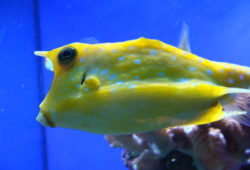The Foxface Rabbitfish
In the following article you will find some basic information on The Foxface Rabbitfish. The Foxface Lo Rabbitfish has a horrendous reputation, but is really, just a very shy guy who when backed into a corner, is not afraid to defend himself.

Contents
Rabbitfish Description
The Badgerfish, or Foxface Rabbitfish (discussed here because it is the most commonly offered in the trade), hails from the western Pacific region in shallow lagoons and is primarily a very brightly coloured yellow, with diagonal black and white bands through the head area. His head region is concave, and his body is extremely thin and oval shaped, so that he may escape into narrow crevices when the occasion arises. He is entirely peaceful by nature, and is known to school when young in the wild, but as with many aquarium specimens, it is best to only attempt to keep one per tank.
Signaus Unimaculatus (One-spot Foxface Rabbitfish)
Some fish experts argue that there is no classification difference between the one-spot and the Lo, with the only difference being a visual one – the one spot has a black circular dot near the posterior. in fact, nowadays, suppliers may call both species by the umbrella term “Lo” (which actually means, Foxface) when offered in pet stores.
Flamboyant Rabbitfish
Cousin to the Surgeonfish or Tang, there is usually a stalemate battle between them when one or the other is introduced to the aquarium. However, this bullying between the two fish, more often than not, dies down in the first week or two. When the Siganus Vulpinus (Foxface Rabbitfish) or the Siganus Unimaculatus (One-spot Foxface Rabbitfish) feels threatened, it will posture and change its appearance to a motley colouration, also incidentally their nighttime colouration, fanning out their fins to threaten any would-be predators. Some have been known to dig their spines into the rockwork nearby, like a trigger, to hold themselves in place. They can change back and forth from their fight/flight colouration amazingly quickly and though spooked easily, they do not undergo long bouts of stress in general like other fish species.
Siganus Vulpinus Care
They are not as prone to ich and bacteria as other fish, possibly due to their clownfish-like slime coat, and are in general, an easily adapted fish to aquaria. They do not actively attack other tank mates, but they will actively defend themselves when there is no other choice. This fish would much prefer to be let alone and seems to fit in among both community fish and aggressive species alike. While the Foxface does have a bad reputation for nipping at corals, provided there is an abundance of algae and other offered foods, this is generally not the case, and it is zooanthids that are more commonly nipped, possibly because they resemble macro algae to the fish.
Herbivorous Badgerfish
Loving the caulerpa algae species in particular, the Foxface Rabbitfish is a welcome addition in an established tank with lots of macro algae present. This fish got its name for the very reason that it is constantly munching on greens and the protruded mouth area, similar in basic shape as a fox’s, is constantly moving in a chewing motion. Pieces of nori and flakes are readily devoured and this primarily herbivorous tank mate, will also usually accept mysid shrimp.
Foxface Venom
His dorsal and anal spines are venomous, so caution should be exercised when the aquarist puts his hands in the tank, but the use of rubber gloves and a visual check before moving things around should be sufficient to avoid the sting, likened to a lionfish’s. The sting is not deadly, but some have said, imagine a bee sting, and then multiply that by one hundred and that’s what you can expect.
The pain usually dies down after a couple of days, but the intensity and swelling are surprising to those that are not aware this fish can and will defend itself when it feels threatened with a sharp jab from his fins. Those who are allergic to stings of flying insects should take extra care, as for them, it is not known whether there is a relationship to the toxin between for example, bees and rabbitfish.
If you are allergic to the toxin in any fish, you must assume that the Foxface will be venomous to you as well, the same might be assumed to be true with subsequent stings, the more often the toxins are introduced into your body, the stronger the reaction can be.



